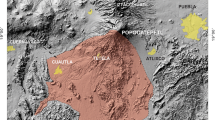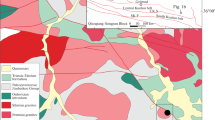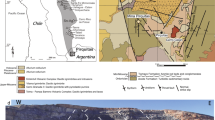Abstract
Cerro Rico de Potosi, Bolivia, is the world's largest silver deposit and has been mined since the sixteenth century for silver, and for tin and zinc during the twentieth century, together with by-product copper and lead. The deposit consists primarily of veins that cut an altered igneous body that we interpret to be a dacitic volcanic dome and its underlying tuff ring and explosion breccia. The deposit is compositionally and thermally zoned, having a core of cassiterite, wolframite, bismuthinite, and arsenopyrite surrounded by a peripheral, lower-temperature mineral assemblage consisting principally of sphalerite, galena, lead sulfosalt, and silver minerals. The low-temperature assemblage also was superimposed on the high-temperature assemblage in response to cooling of the main hydrothermal system. Both the dacite dome and the ore fluids were derived from a larger magmatic/hydrothermal source at depth. The dome was repeatedly fractured by recurrent movement on the fault system that guided its initial emplacement. The dome was extruded at 13.8 ± 0.2 Ma (2σ), based on U-Th-Pb dating of zircon. Mineralization and alteration occurred within about 0.3 my of dome emplacement, as indicated by a 40Ar/39Ar date of 13.76 ± 0.10Ma (1σ) for sericite from the pervasive quartz-sericite-pyrite alteration associated with the main-stage, high-temperature, mineralization. The last thermal event able to reset zircon fission tracks occurred no later than 12.5 ± 1.1 Ma (1σ), as indicated by fission-tract dating. Minor sericite, and magmatic-steam alunite veins, were episodically formed around 11 Ma and between 8.3 and 5.7 Ma; the younger episodes occurring at the time of extensional fracturing at Cerro Rico and wide-spread volcanism in the adjacent Los Frailes volcanic field. None of these younger events appear to be significant thermal/mineralizing events; the exceptionally flat thermal release pattern of 39Ar from sericite and the results of the fission-tract dating of zircon show that none of the younger events was hot enough, and lasted long enough, to cause significant loss of Ar or annealing of zircon fission tracks. U-Th-Pb dating of zircon cores indicates a Precambrian progenitor for some zircons, and REE analyses of dated samples of hydrothermally altered dacite show the presence of a prominent positive Eu anomaly, which constrains interpretations of the origin and evolution of the magmatic/hydrothermal system.
Similar content being viewed by others
References
Ahlfeld, F. (1967) Metallogenetic epochs and provinces of Bolivia. Mineral. Deposita 2:291–311
Ahlfeld, F., Schneider-Scherbina, A. (1964) Los yacimientos minerales y hidrocarburos de Bolivia. Bolivia Departmento Nacional de Geología, Boletin 5, 388 pp
Aitcheson, S.J., Harmon, R.S., Moorbath, S., Soler, P., SoriaEscalante, E., Steele, G., Swainbank, I., Wörner, G. (1995) Pb isotopes define basement domains of the Altiplano, central Andes. Geology 23:555–558
Avila-Salinas, W.A. (1990) Tin-bearing granites from the Cordillera Real, Bolivia; a petrological and geochemical review. In: Kay, S.M., Rapela, C.W., (eds.) Plutonism from Antarctica to Alaska. Geol. Soc. Am. Spec. Paper 241:145–159
Bau, M. (1991) Rare-earth element mobility during hydrothermal and metamorphic fluid-rock interaction and the significance of the oxidation state of europium. Chem. Geol. 93:219–230
Bernstein, M. (1987) Considerations for the future Bolivian Industry; profitable mines through economy of scale. 1986 Internal Report prepared for the Mining Industry Task Force, Ministerio de Minas, La Paz, Bolivia
Bernstein, M. (1989) Expectations for bulk tonnage hard rock and alluvial ores. United Nations Development Program, Project BOL/87/012, La Paz, Bolivia, 18 pp
Bernstein, M., Harrington, R. (1988) Observations on the economic geology and volcanic setting of Cerro Rico de Potosi. IUGS/UN-ESCO Deposit Modeling Workshop, Hydrothermal systems in Volcanic centers, September 4–16, 1988, La Paz, Bolivia
Berry, E.W. (1939) The fossil flora of Potosi, Bolivia. The Johns Hopkins Univ. Studies in Geol. 13:9–67
Brüggen, J. (1934) Grundzüge der Geologie und Lagerstättenkunde Chiles. Heidelberg, 91 pp
Columba, C.M., Cunningham, C.G. (1993) Geologic model for the mineral deposits of the La Joya district, Oruro, Bolivia. Econ. Geol. 88:701–708
Cunningham, C.G., Ericksen, G.E. (1991 a) Exploration guides for precious-metal deposits in volcanic domes. In: Good, E.E., Slack, J.F., Kotra, R.K. (eds.) Seventh Ann. V.E. McKelvey Forum on Mineral and Energy Resources. U.S. Geol. Surv. Circ. 1062:23–24
Cunningham, C.G., McNamee, J., Pinto Vásquez, José, Ericksen, G.E. (1991b) A model of volcanic dome-hosted precious metal deposits in Bolivia. Econ. Geol. 86:415–421
Dalrymple, G.B., Lanphere, M.A. (1971) 40Ar/39Ar technique of K-Ar dating — A comparison with the conventional technique. Earth Planet. Sci. Lett. 12:300–308
Dalrymple, G.B., Lanphere, M.A. (1974) 40Ar/39Ar age spectra of some undisturbed terrestrial samples. Geochim. Cosmochim. Acta 38:715–738
Deen, J.A., Rye, R.O., Munoz, J.L., Drexler, J.W. (1994) The magmatic-hydrothermal system at Julcani, Peru: Evidence from fluid inclusions and hydrogen and oxygen isotopes. Econ. Geol. 89:1924–1938
Dodson, M.H. (1973) Closure temperature in cooling geochrono-logical and petrological systems. Contrib. Mineral. Petrol. 40:259–274
Ericksen, G.E., Luedke, R.G., Smith, R.L., Koeppen, R.P., Urquidi, B.F. (1990) Peraluminous igneous rocks of the Bolivian tin belt. Episodes 13:3–7
Evans, D.L. (1990) Structure and mineral zoning of the Pailaviri section, Potosi, Bolivia. Econ. Geol. 35:737–750
Evernden, J.F., Kriz, S.J., Cherroni, M.C. (1977) Potassium-argon ages of some Bolivian rocks. Econ. Geol. 72:1042–1061
Francis, P.W., Baker, M.C.W., Halls, C. (1981) The Kari Kari caldera, Bolivia, and the Cerro Rico stock. J. Vol. Geotherm. Res. 10:113–124
Graf, J.L., Jr. (1977) Rare earth elements as hydrothermal tracers during the formation of massive sulfide deposits in volcanic rocks. Econ. Geol. 72:527–548
Grant, J.N., Halls, C., Avila Salinas, W., Snelling, N.J. (1979) K-Ar ages of igneous rocks and mineralization in part of the Bolivian tin belt. Econ. Geol. 74:838–851
Halls, C., Schneider, A. (1988) Comentarios sobre la génesis de los yacimientos del cinturón estañífero boliviano. Rev. Geol. Chile 15:41–56
Heald, P., Foley, N.K., Hayba, D.O. (1987) Comparative anatomy of volcanic-hosted epithermal deposits: Acid-sulfate and adulariasericite types. Econ. Geol. 82:1–26
Hemley, J.J., Hostetler, P.B., Gude, A.J., Mountjoy, W.T. (1969) Some stability relations of alunite. Econ. Geol. 64:599–612
Hurford, A.J. (1986) Cooling and uplift patterns in the Lepontine Alps, South Central Switzerland and an age of vertical movement on the Insubric fault line. Contrib. Mineral. Petrol. 92:413–427
Ishihara, S. (1977) The magnetite-series and ilmenite-series granitic rocks. Mining Geol. 27:293–305
Japan International Cooperation Agency (1985) K-Ar ages of mineralization at the Caracoles, Siglo XX, Colquechaca, Huari Huari, Unificada, Tasna, Inocentes and Buena Vista mines in Bolivia. In. Proy. Inst. Geol. Econ. Universidad Mayor de San Andres de Bolivia, 2, 270–280
Lehmann, B. (1990) Metallogeny of tin. In: Bhattacharji, S., Friedman, G.M., Neugebauer, H.J., Seilacher, A. (eds.) Lecture notes in Earth Sciences, 32. Springer, Berlin Heidelberg New York, 211 p
Lehmann, B. (1994) Petrochemical factors governing the metallogeny of the Bolivian tin belt. In: Reutter, K.J., Scheuber, E., Wigger, P.J. (eds.) Tectonics of the Central Andes. Springer, Berlin Heidelberg New York, pp. 317–326
Lindgren, W., Creveling, J.G. (1928) The ores of Potosi, Bolivia. Econ. Geol. 55:233–262
Ljunggren, P. (1964) The tin deposits of Rondônia, Brazil, as compared with the Bolivian mineralization. Geol. Foren. Stockholm Förh. 85:431–435
Meyer, C., Hemley, J.J. (1967) Wall rock alteration. In: Barnes, H.L. (ed.) Geochemistry of hydrothermal ore deposits, Holt, Rinehart and Winston, New York, pp. 166–235
Miller, B., Singewald, J. (1919) The mineral deposits of South America. McGraw-Hill 597 pp
Naeser, C.W. (1979) Fission-track dating and geologic annealing of fission tracks. In: Jäger, E., Hunziker, J.C. (eds.) Lectures in isotope geology. Springer, Berlin Heidelberg New York, pp. 154–169
Noble, D.C., Silberman, M.L. (1984) Evolutión volcánica é hidrotermal y cronología de K-Ar del distrito minero de Julcani, Peru. Bol. Soc. Geol. Perú, vol jubilar, LX Aniversario 5:1–35
Omiste, M. (1893) Cronicas Potosinas. Editora “El Siglo Ltda.”, Potosi, Bolivia
Pinto-Vásquez, J. (1993) Volcanic dome-associated precious and base metal epithermal mineralization at Pulacayo, Bolivia. Econ. Geol. 88:697–700
Redwood, S.D. (1987) The Soledad caldera, Bolivia: A Miocene caldera with associated epithermal Au-Ag-Cu-Pb-Zn mineralization. Geol. Soc. Am. Bull. 99:395–404
Rollinson, H. (1994) Origin of felsic sheets in the Scourian granulites: new evidence from rare earth elements. Scot. J. Geol. 30:121–129
Rye, R.O. (1993) The evolution of magmatic fluids in the epithermal environment: the stable isotope perspective. Econ. Geol. 88:733–753
Rye, R.O., Bethke, P.M., Wasserman, M.D. (1992) The stable isotope geochemistry of acid sulfate alteration. Econ. Geol. 87:225–262
Schneider, A. (1985) Eruptive processes, mineralization and isotopic evolution of the Los Frailes Karikari region/Bolivia. Unpublished Ph. D. Dissertation, Imperial College, University of London, England
Schneider, A. (1987) Eruptive processes, mineralization and isotopic evolution of the Los Frailes Karikari region, Bolivia. Rev. Geol. Chile 30:27–33
Schneider, A., Halls, C. (1985) Chronology of eruptive processes and mineralization of the Frailes Karikari volcanic field; eastern Cordillera, Bolivia. Comunicaciones 35:217–224
Schneider, H.J., Lehmann, B. (1977) Contribution to a new genetical concept on the Bolivian tin province. In: Klemm, D.D., Schneider, H.J. (eds.) Time- and stratabound ore deposits. Springer, Berlin Heidelberg New York, pp. 153–168
Sillitoe, R.H., Halls, C., Grant, J.N. (1975) Porphyry tin deposits in Bolivia. Econ. Geol. 70:913–927
Snee, L.W., Sutter, J.F., Kelly, W.C. (1988) Thermochronology of economic mineral deposits: dating the stages of mineralization at Panasqueira, Portugal, by high-precision 40Ar/39Ar age spectrum techniques on muscovite. Econ. Geol. 83:335–354
Steiger, R.H., Jäger, E. (1977) Subcommission on geochronology; convention on the use of decay constants in geo- and cosmochronology. Earth Planet. Sci. Lett. 36:359–362
Steinmann, Gustav (1922) Über die junge Hebung der Kordillere Südamerikas. Geol. Runds. 13:1–8
Stoffregen, R.E. (1987) Genesis of acid sulfate alteration and Au-Cu-Ag mineralization at Summitville, Colorado. Econ. Geol. 82:1575–1591
Stoffregen, R.E., Rye, R.O., Wasserman, M.D. (1994) Experimental studies of alunite I. 18O and D fractionation factors between alunite and water at 250–450 °C. Geochem. Cosmochim. Acta 58:903–916
Sugaki, A., Kojima, S., Shimada, N. (1988) Fluid inclusion studies of the polymetallic hydrothermal ore deposits in Bolivia. Mineral. Deposita 23:9–15
Sugaki, A., Ueno, H., Shimada, N., Kusachi, I., Kitakaze, A., Hayashi, K., Kojima, S., Sanjines, V.O. (1983) Geological study on the polymetallic ore deposits in the Potosi district, Bolivia. Science Reports Tohoku University, Series III 15:409–460
Suttill, K.R. (1988) Cerro Rico de Potosi. Eng. Min. J. March 1988, pp. 50–53
Tarney, J., Jones, C.E. (1994) Trace element geochemistry of orogenic igneous rocks and crustal growth models. J. Geol. Soc. London 151:855–868
Thorman, C.H., Drew, L.J. (1988) A report on site visits to some of the largest tin deposits in Brazil. U.S. Geol. Surv. Open-File Rep. 88-0594, 19 p
Turneaure, F.S. (1960a) A comparative study of major ore deposits of central Bolivia. Part I. Econ. Geol. 55:217–254
Turneaure, F.S. (1960b) A comparative study of major ore deposits of central Bolivia. Part II. Econ. Geol. 55:574–606
Turneaure, F.S. (1971) The Bolivian tin province. Econ. Geol. 66:215–225
Turneaure, F.S., Marvin, T.C. (1947) Notas perliminares sobre la geología del distrito de Potosi. Mineria Boliviana 36:3–8
Ueno, H., Sugaki, A. (1984) K-Ar ages of mineralization at the Morocala, Avicaya, Bolivar, Unificada, Chorolque and Tasna mines in Bolivia: Ann. Rep. JICA (Japan International Cooperation Agency) and UMSA (Universidad Mayor de San Andres), Part II 1:1162–1170
Urquidi-Barrau, F. (1989) Tin and tungsten deposits of the Bolivian tin belt. In: Ericksen, G.E., Canas Pinochet, M.T., Reinemund, J.A. (eds.) Geology of the Andes and its relation to hydrocarbon and mineral resources. Houston, Texas. Circum-Pacific Council for Energy and Mineral Resources Earth Science Series 11: 313–323
Weaver, B.L., Tarney, J. (1981) Lewisian gneiss geochemistry and Archean crustal development models. Earth Planet. Sci. Lett. 55:171–180
Wilson, G.A., Eugster, H.P. (1990) Cassiterite solubility and tin speciation in supercritical chloride solutions. In: Spencer, R.J., Chou, I-Ming (eds.) Fluid-mineral interactions: a tribute to H.P. Eugster. Geochem. Soc. Spec. Pub. 2:179–195
Zartman, R.E., Cunningham, C.G. (1995) U-Pb zircon dating of the 13.8-Ma dacite volcanic dome at Cerro Rico de Potosi, Bolivia. Earth Planet. Sci. Lett. 133:227–237
Zartman, R.E., Dyman, T.S., Tysdal, R.G., Pearson, R.C. (1995) U-Pb ages of volcanogenic zircon from porcellanite beds in the Vaughn Member of the mid-Cretaceous Blackleaf Formation, southwestern Mont. US Geol. Surv. Bull. 2113-B, p. B1-B16
Author information
Authors and Affiliations
Rights and permissions
About this article
Cite this article
Cunningham, C.G., Zartman, R.E., McKee, E.H. et al. The age and thermal history of Cerro Rico de Potosi, Bolivia. Mineral. Deposita 31, 374–385 (1996). https://doi.org/10.1007/BF00189185
Received:
Accepted:
Issue Date:
DOI: https://doi.org/10.1007/BF00189185




